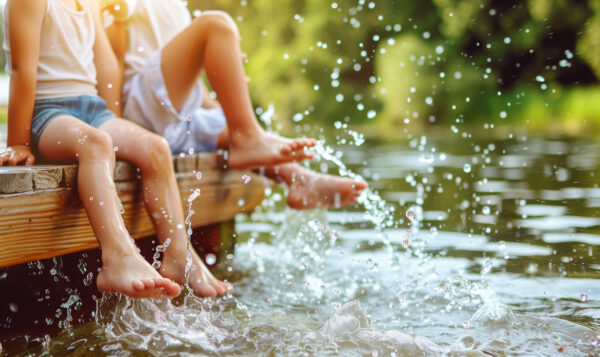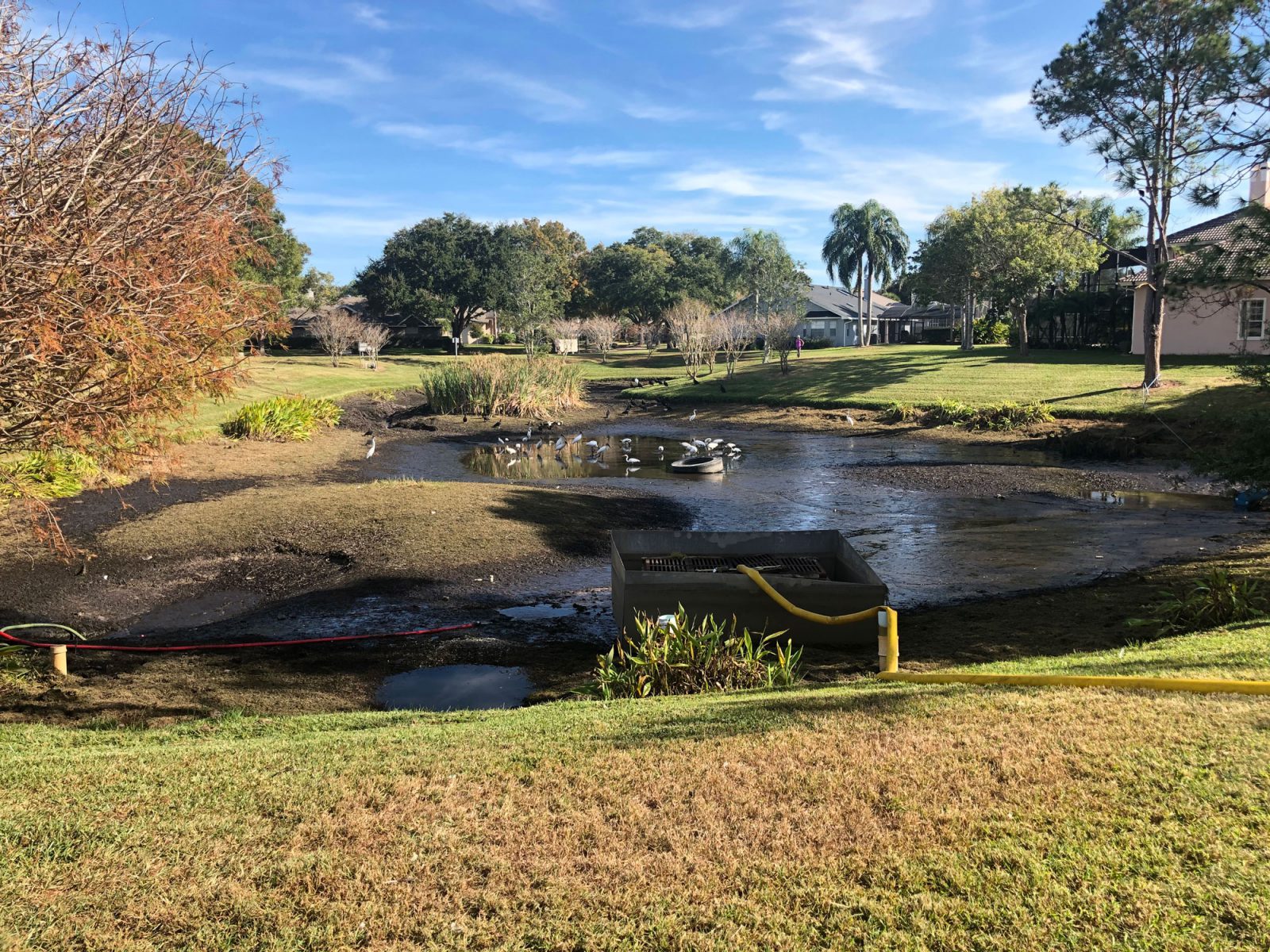
Pond Dredging: What Is It & Why Is It Important
If you manage an HOA, golf course, stormwater facility, fishing pond, or another type of waterbody, you may worry that it will need to be dredged at some point. Why dredge a pond? All ponds go through a natural cycle called eutrophication that eventually leads to its slow decline and loss of volume over time.
Sediment and silt make their way into ponds through stormwater runoff and begin to cause all kinds of problems. Excess nutrient levels from the sedimentation can lead to water quality issues that endanger aquatic life and virtually ruin the functionality, aesthetics, and safety of the waterbody.
Several proactive management strategies are available that help slow a waterbody’s aging process – these include fountains and aeration, nutrient remediation, mechanical harvesting, and shoreline management. These practices help keep your lake or pond balanced and healthy; however, there will still come a time where your waterbody has reached the end of its lifespan. This marks the need for sediment removal via dredging.
What Is Pond Dredging?
Sedimentation is the process of sand, silt, and other types of debris accumulation at the bottom of a pond. If left unchecked over time, this can cause significant issues. For example, it can reduce the depth of the pond and lead to poor water quality conditions that threaten fish, waterfowl, and other aquatic wildlife. It can also begin to exacerbate erosion issues. Dredging is a fast, efficient solution for removing muck and detritus to restore depth in ponds.
It’s important to note that while dredging is a highly effective way to “reset” a waterbody, it is extremely expensive – community associations often begin budgeting a decade or more in advance. It is also an invasive transformation of the aquatic ecosystem, uprooting natural habitat and food sources that have supported the freshwater food chain. Prolonging dredging for as long as possible through proactive management is the most effective way to save money and protect the ecological health and function of the ecosystem.
Why Dredge a Pond?
Sedimentation is harmful to ponds in many ways. The accumulation of bottom muck can create a dangerous cycle that expedites a lake or pond’s aging in many ways. The sediment and pollutants that settle to the bottom are rich in undesirable nutrients that fuel the overgrowth of nuisance weeds and algae. Once this growth dies and deteriorates, it sinks to the bottom, further contributing to the problem. If left unmanaged, you will eventually end up with a shallow, murky, smelly swamp full of nuisance and invasive aquatic plants.
Too much sedimentation also increases the chances of submersible pumps and fountains becoming clogged, which, in turn, increases the costs of long-term maintenance and repairs. A decrease in water depth can also limit recreation and boat access in lakes and ponds. Likewise, sedimentation can increase the risks of flooding by reducing the capacity of the pond to hold stormwater.
Benefits of Dredging Your Pond
Dredging your pond offers many benefits, such as:
- Restores the aquatic ecosystem for plants, fish, and wildlife
- Removes unwanted nutrients from the sediment and water column, improving water quality
- Prevents the development of harmful algal blooms, which are toxic to humans, pets, and wildlife
- Increases waterbody volume and depth
- Facilitates more recreational and functional use of the pond
- Reduces water cloudiness and bad odors
The bottom line is that dredging restores aging lakes and ponds, allowing them to again become sustainable and healthy aquatic ecosystems.
How to Tell If a Pond Needs Dredging?
If you can’t recall the last time your pond was dredged (or if it ever was!), chances are you should begin budgeting for it. Keep an eye out for some common signs that indicate it’s time to call in a professional.
Smaller Shoreline and Shallow Water
Throughout the year, various types of organic debris, including twigs, leaves, and sediment, make their way into the depths of your pond. When fall comes, trees shed their leaves, and the rains that follow wash those leaves into the water body. Spring and summer rains bring huge amounts of runoff and with that excess amounts of sediment build up on the pond bottom.
This sediment and organic debris will cause the pond to become shallower and narrower, in effect, to shrink into wetlands.
Unsightly Algae Blooms and Aquatic Weeds
The muck that collects on the pond’s bottom consists of a huge amount of nutrients that feed algae and aquatic weeds and cause excessive growth that can use up all the oxygen in the water, causing fish and other aquatic plants to die off. These algal blooms usually happen during the warm summer months and can quickly cover the entire pond with a foul-smelling, unsightly yellow/green mat of algae.
Excessive algae blooms and aquatic weeds are a sign of nutrient loading and poor water quality, which is often caused by excess sediment levels at the bottom of the pond. This can be a sign that your pond is aging and may be in need of a sediment removal solution in order to restore ecological health.
Begin Preparing Now
While every single waterbody is susceptible to the effects of aging, each and every one can benefit from proactive management solutions that preserve the aquatic ecosystem for as long as possible. When implemented consistently, sustainable strategies can give years – or even decades – back to your waterbody.
One of the best tools to prevent the need for dredging is mechanical hydro-raking. Hydro-raking is a similar sediment removal technique that is much less invasive and expensive. A hydro-rake is essentially a floating barge mounted with a backhoe that can scoop 500 pounds of muck and detritus in a single scoop and deposit it onshore for removal from the site. Hydro-raking cannot “reset” the waterbody like dredging can, but can be very impactful when used in conjunction with other eco-friendly maintenance tools. Contact the experts today to learn more about our SOL Pro Annual Management programs today.
Be Proactive with Muck Removal
SOLitude Lake Management is a nationwide environmental firm committed to providing sustainable solutions that improve water quality, enhance beauty and preserve natural resources.
SOLitude’s team of aquatic scientists specializes in the development and execution of customized lake, stormwater pond, wetland and fisheries management programs. Services include water quality testing and restoration, algae and aquatic weed control, installation and maintenance of fountains and aeration systems, shoreline erosion control, muck and sediment removal and invasive species management. SOLitude partners with homeowners associations, golf courses, private landowners, businesses and municipalities. SOLitude Lake Management is part of Rentokil, a leading business services company, operating across the United States, Canada and Puerto Rico.
For more information, visit SOLitude Lake Management at solitudelakemanagement.com, and connect on Facebook, LinkedIn and Twitter.














